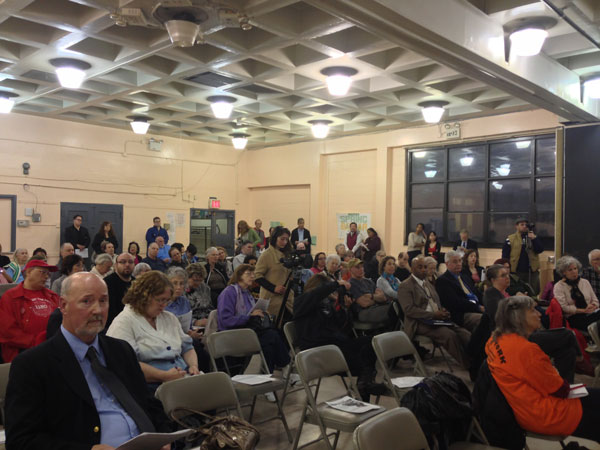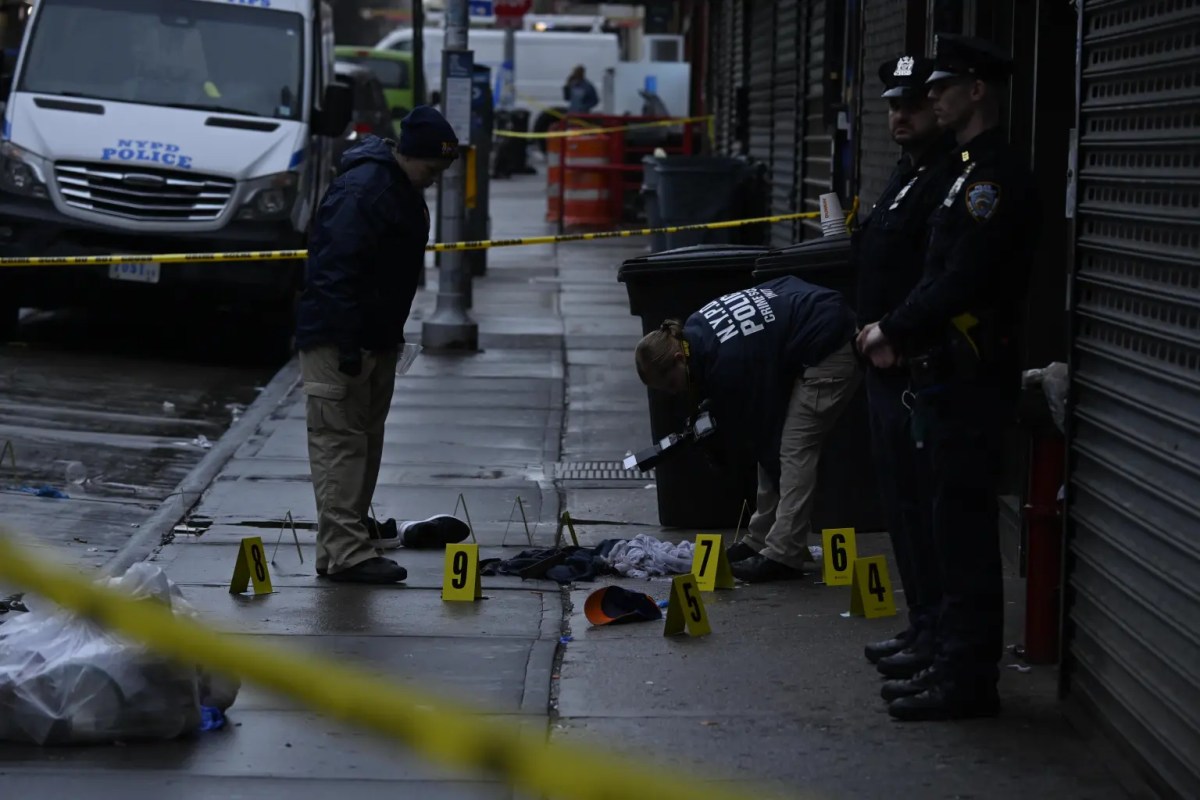
On April 11, at Fulton Auditorium, Chelsea residents gathered in Fulton Auditorium to voice their opinions; USPS representative Joseph J. Mulvey (foreground, left) listens to the complaints.
BY MAEVE GATELY | On the evening of April 11, Jonathan Smith — President of the New York Metro Area Postal Union — stood before dozens of angry Chelsea residents, declaring that the proposal to relocate the Old Chelsea Station (OCS) Post Office was the latest in a series of “lies, lies, and more lies” by the United States Postal Service (USPS).
“The plan is about big money,” thundered Smith, who asked when the USPS “will at least give us the decency of truth and respect,” and concluded by assuring Joe Mulevy (the attendant USPS representative) that, “If you win, it will be over my dead body!” He sat down to cheers from the audience.
The meeting, which was sponsored by Community Board 4 (CB4) and took place in Fulton Auditorium (119 Ninth Avenue), was the public comment hearing required by law before the USPS announces any official decision regarding the relocation. Of the 19 Chelsea residents, a State Senator, an Assemblymember and various CB4 members who spoke, not a single one argued for the relocation to take place.
Possible closure of the architecturally significant facility (at 217 West 18th Street, between Seventh and Eighth Avenues) was a scenario first brought to the community’s attention in January, when an unassuming letter posted in OCS was read by 79-year-old Village resident Barbara Ruether. Since then, reaction by preservationists, loyal OCS customers and elected representatives has been as consistent and unyielding as the central argument put forth by the USPS — which maintains it can’t afford to maintain a 43,000-square-foot building, when the services that take place there require only 19,000 square feet. Selling the building would, the USPS asserts, allow it find a smaller space within the same zip code.
In an attempt to halt the relocation process, CB4 sent the Postmaster General a letter signed by seven local elected officials: U.S. Representatives Jerrold Nadler and Carolyn Maloney, State Senator Brad Holyman, Assemblymembers Richard Gottfried and Deborah Glick, City Council Speaker Christine Quinn and Manhattan Borough President Scott Stringer. The letter called for a more transparent decision-making process and a public comment meeting (an obligatory step in the closure process, fulfilled through USPS attendance at the April 11 forum, as well as at a March 14 meeting of the Manhattan Borough Board).
In an April 15 email to Chelsea Now, Connie Chirichello, USPS Corporate Communications representative for New York City and Long Island, commented on the decision-making process, noting that, “Postal officials are evaluating all avenues in the facility optimization process. Public comment is an important part of the process.”
CB4 Chair Cory Johnson opened the April 11 meeting by thanking the residents in attendance and expressing his desire to combat the USPS’s impending decision. “I know the people here tonight are just a small fraction of people who care very deeply that the post office stays in its current location,” he declared to applause from the attendants, vowing that, “We’re all banding together on this, the Community Board, the elected officials and you!”
The letter was sent before the meeting itself, he assured, in order to make sure the federal government halted the process before the sale could occur, and now that public had the chance to gather, “A full room of Chelsea residents sends a strong message that our community wants [the post office] to remain where it is.”
Joseph J. Mulvey, Real Estate Specialist for the United States Postal Service, came down from Boston to read an official statement regarding the proposal, and to field any related questions. He emphasized that, if a relocation should in fact occur, it will be to a yet-to-be-determined-location “within the same postal area. I think that’s important,” and proceeded to read certain sections of his statement a second time in order to allow them to sink in.
He clearly did not expect the angry and impassioned group of Chelsea residents that awaited him, however, and spent most of the evening sitting in the audience and listening to remarks and outcries — typified by comments such as, “Postal management lies to everybody,” and, “He’s reading a letter and trying to bullshit us.”
Johnson had to step in several times, first to prevent residents from shouting at Mulvey, and then to prevent Mulvey from responding to each accusation with a rebuttal. “We all feel really strongly about this,” Johnson shouted at the angry room, reassuring them that “This is his job. Be respectful, don’t catcall.”
Mulvey spoke of the necessary re-alignment of infrastructure as a response to the 40 percent drop in net volume of mail in recent years. The USPS has “exhausted its borrowing,” and lost billions of dollars, he maintained, and this sale is merely one in a number of downsizing measures. The Depression-era building, which was construed in 1935, contains two bas relief stone panels by American artist Paul Fiene, and is listed on the National Register of Historic Places. It is not landmarked by the city, however — a status that might protect it from being sold.
Comments from community members ranged from anger and disbelief to practical suggestions for budgeting strategies. All felt that OCS is a central and crucial part of the community, and expressed concern that, were it to move to a less-expensive location along 12th Avenue or further north, elderly residents would lose access to a vital service in their neighborhood.
Many residents compared this battle to the one waged over the closed St. Vincent’s Hospital — believing the community is losing its essential infrastructure, bit by bit.
Rosa Maria de la Torre, Program Coordinator of the Chelsea Housing Guild, said she sees the proposal as “a direct attack on the working class, on people of color, on seniors.” Many residents agreed with this sentiment, invoking the recent closing of the Bronx Central Station — whose public hearing also took place at the March 14 meeting of the Manhattan Borough Board (which, with a start time of 8:30am, occurred when the majority of working-class residents were unable to attend).
Assemblymember Dick Gottfried voiced his outrage with the way the USPS conducted the notification process, and assured Mulvey that, “If the past is any indication of the future, [this community] is gonna fight pretty damn hard.”
A more pragmatic approach was taken by Lesley Doyel of Save Chelsea, who wondered whether the USPS could afford a new space in a neighborhood whose rents are soaring. Dan Zachman, of the American Postal Workers Union, asked Mulvey, “How are you gonna get something cheaper than what you already own?”
Dan Milner, a professional geographer, assured Mulvey, “You not only have a suitable location, you have the best one,” and asked whether the USPS has considered selling the air rights to the building in order to increase revenue. When asked about this option in a same-day follow-up to her April 15 email, Chirichello responded, “I can’t answer that. However, all potential avenues to bring the USPS back to financial stability are possible.”
In response to a question regarding potential relocation spots for the station, Chirichello commented, “At this time there is no discussion on the table regarding possible relocation sites.” As to whether the USPS has considered leasing part of the space in order to maintain the rest, she added, “If we did move forward, and should possible buyers offer us space to continue retail services in the building, this option would be considered.”
Chirichello assured Chelsea Now that, “Should we move forward and relocate customers could expect the same friendly service they have come to expect and deserve from the same postal staff they have come to know on a first name basis.” The new facility, she vowed, would be state-of-the-art, “with plenty of space to accommodate postal operations and customers,” and those who had PO boxes at OCS would keep their same box numbers.
At the meeting’s conclusion, a heated two hours later, Mulvey stood back up and thanked the residents for their comments. His closing remarks, which were surprisingly diffident and articulate for a man who had just spent the past few hours being attacked, urged the community to put their grievances in writing. “There were some good comments here tonight,” he said, smiling slightly, noting that although helpful, a few of the comments were “a bit off-color.”
The 15-day comment period ends on April 26. Comments may be directed in writing to Joseph J. Mulvey, Vice President of Facilities Implementation, U.S. Postal Service, 2 Congress Street, Room 8, Milford, MA, 01757-9998. CB4 notes that you may also send a copy to rbenfatto@cb.nyc.gov — or snail mail to District Manager, Manhattan CB4, 330 West 42nd Street, 26th floor, New York, NY, 10036.

















